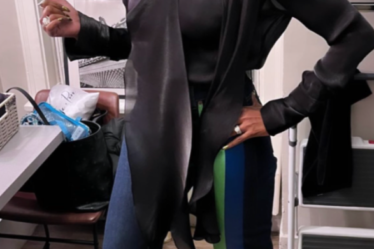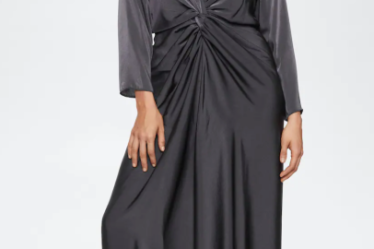Last year, Mielle Organics’ rosemary mint hair and scalp oil sparked an online frenzy, with TikTok users gushing over its reportedly remarkable results in prompting hair growth. But when it went viral again earlier this month, it was for less celebratory reasons.
On Sept. 2, TikTok user Danesha Mo’Nék posted a video in which she alleged her hair fell out after using the oil, alongside the brand’s shampoo and conditioner. The video garnered more than 70,000 views — and a stitched version by another content creator reached more than 4 million — prompting dozens of comments and videos from people alleging they’d had a similar experience with Mielle’s products. Some claimed to have developed bald spots, scalp irritation and thinning hairlines after using the oil.
In a Sept. 9 response, Monique Rodriguez, Mielle’s founder and chief executive, gave an impassioned speech to the brand’s “amazing community” in a video shared on both her personal Instagram account and Mielle’s official page.
“We’ve always taken great care in ensuring the cost and the quality of our products and that commitment has never wavered,” she said. ”If you have any doubts, I encourage you to explore our labels.”
The rosemary mint oil “is trusted by our team,” a spokesperson for Mielle told BoF in a statement, adding: “We constantly evaluate the quality of our products for compliance and safety … We take consumer feedback seriously and can share that none of the negative experiences alleged have been medically confirmed as health issues caused by our products.”
It’s not the first time a haircare brand has come under fire for claims that its products caused harm — or that a CEO turned to social media to tackle the issue. Last year, Olaplex’s then-chief executive JuE Wong took to Instagram in an attempt to debunk allegations its products resulted in hair loss, breakage, and scalp injury. DevaCurl, a premium brand for curly-haired women, faced backlash in 2020 after a viral YouTube video from influencer Ayesha Malik claimed the products were causing hair loss; a stream of lawsuits soon followed.
Rodriguez, who is one of a handful of Black women to build, scale, and sell a multimillion-dollar beauty brand, faces a more complex challenge than her predecessors.
Mielle, which she sold to P&G in January 2023, caters to Black and multicultural women, a group with a historically fraught relationship with beauty brands. Decades of “hair trauma” — resulting from pressure to conform to white beauty standards through heat styling and harsh chemical relaxers — has made Black women especially sensitive about their hair, from how it’s styled to the products they use and who makes them, said Kayla Greaves, a beauty expert and consultant.
Rodriguez’s sale of Mielle to P&G — much like SheaMoisture and Carol’s Daughter’s sales to Unilever and L’Oréal in 2017 and 2014, respectively — was met with scepticism from Black consumers who worried a white-led conglomerate might alter product formulations. Rodriguez addressed those concerns on Instagram last year, explaining the value of the brand’s new “partnership” and noting that there were no plans to change product formulations.
Still, much of the backlash this month focused on the new ownership, with some labelling Rodriguez a sellout.
“As Black people, we historically have not had a lot of options when it comes to hair care,” Greaves said. “Mielle was a brand that people really loved, because it was very high quality [and] affordable … and was Black-owned … so we held it very dear.”

As brands have argued in the face of these complaints, many factors, from hormonal changes to stress to genetics and lifestyle factors, can contribute to hair loss. But even unproven claims can cause lasting reputational harm. Today, the first page of results in a Google search for DevaCurl — which paid a $5.2 million class action settlement in 2021 — surfaces Reddit posts and articles about the allegations.
How Mielle navigates the coming months, including paying attention to the sensitivities and nuances of its core demographic of Black consumers, will determine whether this is a short-term setback or a threat to the brand’s long-term viability.
“If this were my brand, I would take it really seriously, and over plan and over-execute,” said Scott Markman, founder and president of MonogramGroup, a global branding agency. “You’re not completely in charge of this moment — and when this kind of issue is out there, it can spread and become amplified.”
A Plan of Action
When negative allegations gain traction on social media, companies should act swiftly, creating a months-long strategic plan that includes new marketing efforts and even in-person meetings with affected customers, Markman said. Engaging directly with customers, listening to their concerns, and demonstrating empathy can go a long way in rebuilding trust, experts say.
Like Rodriguez, brands might begin by addressing concerns on the platform where the backlash started or is most prevalent, such as Instagram, with “transparency and authenticity,” Markman said. But if they choose this approach, leaders should avoid sounding overly defensive or emotional, as this can alienate consumers — particularly when the issue is as personal as hair loss, Greaves said.
“Don’t have an emotional reaction to this, but have a factual reaction to it,” she said. “Be as transparent as possible, but take the emotion out of it.”
Companies should be cautious not to stop at social media, a common and “naive approach” of brands born in the digital age who assume backlash begins and ends in that channel, said Markman.
In fact, the next step is often to redirect the conversation off of social media and offer more discreet options for feedback. This can include setting up a dedicated email address for complaints or creating a phone hotline where calls are consistently fielded, Markman said.
In addition to its CEO’s social media commentary, Olaplex — which succeeding in having a class action lawsuit brought by 100 alleged customers dismissed by a judge last year — posted the results of independent third-party lab tests on its website (still available today) to demonstrate its products are “safe and effective.”
As part of its recovery, Mielle also has to play the long game in managing scrutiny around its acquisition.
In its statement, the brand said no changes have been made to its formulations under P&G. However, experts note that it’s common for large companies to tweak formulas, often for cost savings. Even minor adjustments to ingredient percentages can significantly affect a product’s performance, said Nausheen Qureshi, a biochemist and cosmetic scientist. Meanwhile changing manufacturing facilities or processes, even with the same formula, could alter results, she said.
Mielle should address accusations of this kind head-on, investigate any changes, and communicate the findings to consumers along with a plan to rectify any unforeseen consequences, Markman said.
If legal challenges arise, they could add another layer of complexity. Mielle might need to tap into P&G’s crisis management and legal resources, but Markman cautioned that as a smaller entity within a massive conglomerate, overextending those resources could make Mielle a dispensable liability. (BoF could not find any evidence of pending litigation against the brand.)
“If this gets the attention of P&G finance people, and they have to put a lot of money behind recovery … that can be a bigger problem for Mielle,” he said. “I’d rather over invest in strategy and tactics that are faster, less expensive and more controllable at the brand level.”
Before the Fallout
Still, the most crucial step hair care brands can take to avoid this sort of blowback happens long before the fallout begins: conducting clinical trials and tests to document product safety and effectiveness, Qureshi said. (For its part, Mielle said on Instagram that its products have undergone “rigorous and frequent” testing by “internal and third-party independent labs” and its rosemary oil and shampoo were “dermatologically tested for skin safety,” with no issues.)
Dermatological tests (such as the ones on Olaplex’s website) which provide evidence that a product won’t harm the scalp or surrounding skin, are a “standard and cheap” starting point, Qureshi said. However, hair brands should aim to go further by investing in ongoing (and more expensive) lab tests and clinical studies that examine a product’s impact on shedding, moisture retention, and the hair’s growth cycle.
“All brands — regardless of what they’re doing or the type of product — should be putting them through appropriate tests that go beyond telling us how good the product is or isn’t,” Qureshi said.



